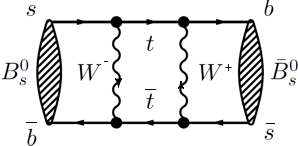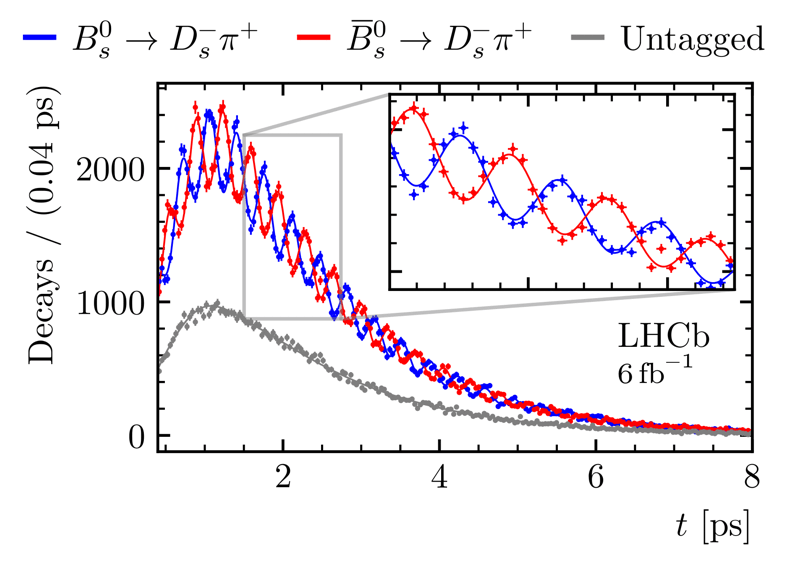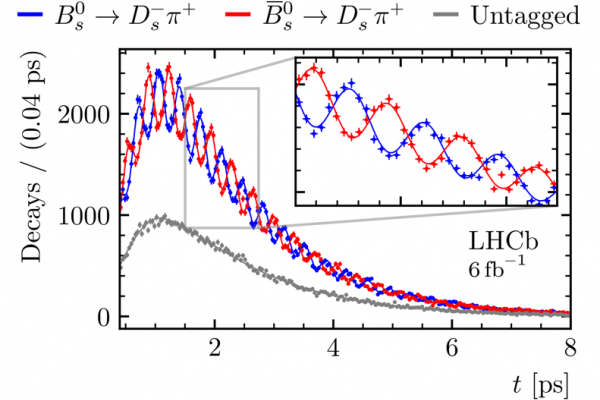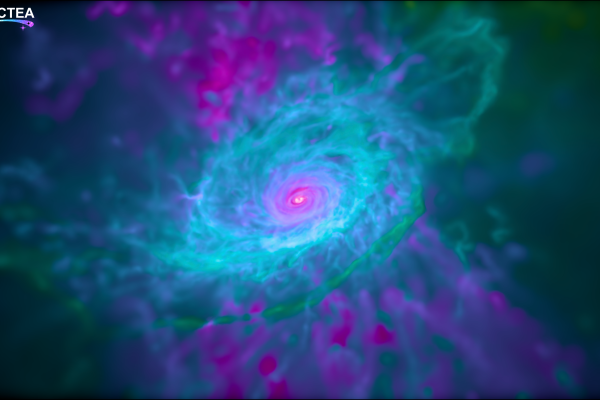The LHCb collaboration has precisely determined the frequency of the oscillation, which is a spectacular and fascinating feature of Quantum Mechanics predicted by Gell-Mann and Pais in the 1950s. They presented their results in a paper published in Nature Physics on January 6.
Gell-Mann and Pais noticed that both the neutral strange meson , and its antiparticle
, decay into a pair of pions, π+π–. Therefore, a
meson can turn into
meson and vice versa following the reaction
↔ π+π–↔
. Thus the two particles,
and
, should be considered in quantum mechanics as a single two-state system. The quantum mechanical treatment leads to the particle-antiparticle oscillation pattern.
In particular, for B mesons, this phenomenon was observed using proton-proton collisions at the LHCb detector at the Large Hadron Collider at CERN. In this experiment, researchers make protons collide and obtain and
mesons as a result. These mesons can directly decay through the processes:
However, there is a secondary, less probable process that the laws of Quantum Mechanics predict, which is the oscillation of these neutral mesons:

Credit: LHCb collaboration
To determine that a meson has oscillated, first we need to know its quark composition right after it is produced in the proton-proton collision. Quarks are the elementary particles that form mesons, so by analysing the quark content of the particle we can determine if it corresponds to a or a
meson. Secondly, we need to know the quark composition after the B meson decays into other particles. This way, we can know if the meson has oscillated in between these two instants. For example, if we part from a
meson and we obtain the
products after the decay, we can confirm that the meson has oscillated into its antiparticle:
In the following figure, we can see the number of events detected that had oscillation between the mesons (in red) and no oscillation (in blue). The total number of events measured at a certain instant is proportional to the number of mesons present at that time, therefore, if the events with oscillation increase, the ones without oscillation must decrease, making the sum of both proportional to the total number of mesons present at that instant. That is why the minimums of the red line correspond to the maximums of the blue one and vice versa.

Credit: LHCb collaboration
Even more, the oscillation frequency is measured and calculated with such a precision that it allows us to test the Standard Model comparing the observed value of this frequency to the value predicted by the theory. This also provides one of the strongest constraints to alternative models beyond the Standard Model.
The image of the oscillations is a beautiful visual example of the quantum-mechanical nature of our universe.
Read more in the LHCb paper and conference presentation. Preliminary results have been already presented at Les Rencontres de Physique de la Valée d’Aoste.
The LHCb collaboration
The LHCb collaboration comprises numerous international institutions worldwide, including the Institute of Cosmos Sciences of the University of Barcelona. Several members of our Institute are part of this collaboration, such as Alejandro Alfonso Alberto, José María Fernández-Tenllado Arribas, Paula Garcia Moreno, Lluís Garrido, Pere Gironella Gironell, Sergio Gómez Fernández, Eugeni Graugés, Aniol Lobo, Albert Lopez, Carla Marín, Joan Mauricio and Ricardo Vázquez.



